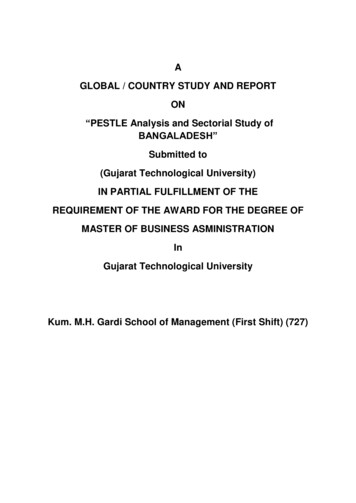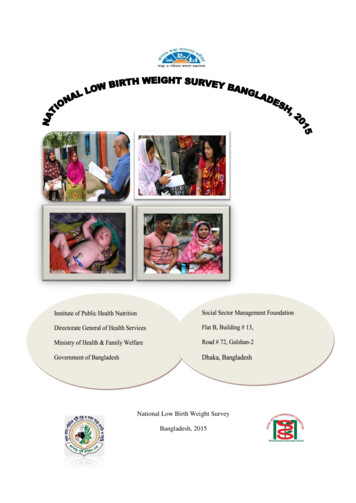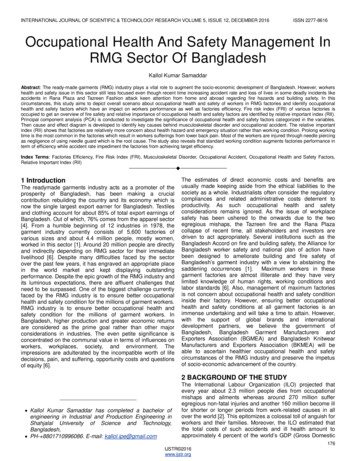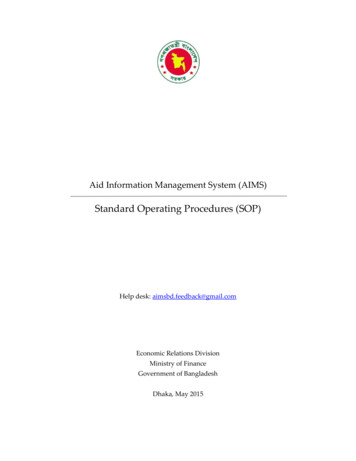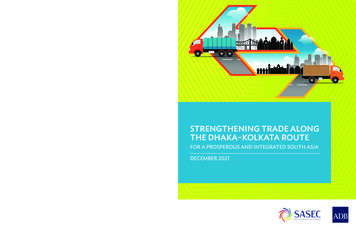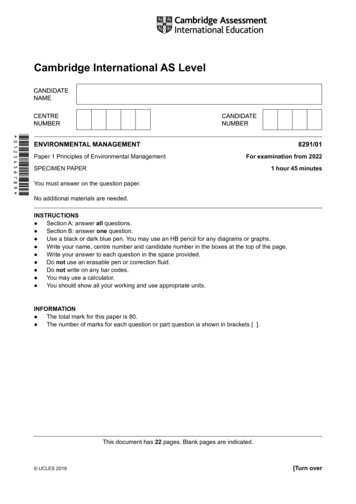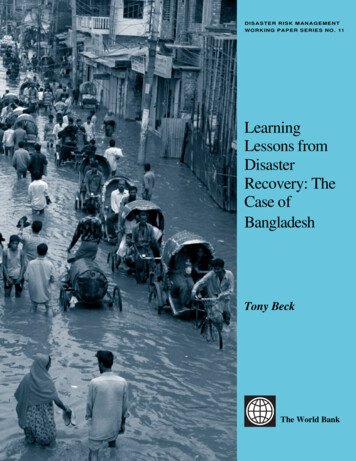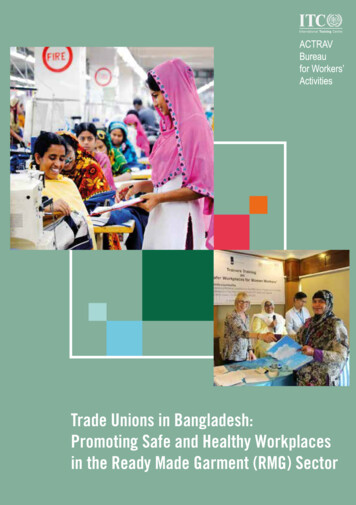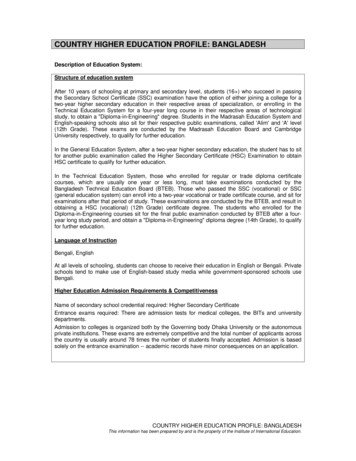
Transcription
COUNTRY HIGHER EDUCATION PROFILE: BANGLADESHDescription of Education System:Structure of education systemAfter 10 years of schooling at primary and secondary level, students (16 ) who succeed in passingthe Secondary School Certificate (SSC) examination have the option of either joining a college for atwo-year higher secondary education in their respective areas of specialization, or enrolling in theTechnical Education System for a four-year long course in their respective areas of technologicalstudy, to obtain a "Diploma-in-Engineering" degree. Students in the Madrasah Education System andEnglish-speaking schools also sit for their respective public examinations, called 'Alim' and 'A' level(12th Grade). These exams are conducted by the Madrasah Education Board and CambridgeUniversity respectively, to qualify for further education.In the General Education System, after a two-year higher secondary education, the student has to sitfor another public examination called the Higher Secondary Certificate (HSC) Examination to obtainHSC certificate to qualify for further education.In the Technical Education System, those who enrolled for regular or trade diploma certificatecourses, which are usually one year or less long, must take examinations conducted by theBangladesh Technical Education Board (BTEB). Those who passed the SSC (vocational) or SSC(general education system) can enroll into a two-year vocational or trade certificate course, and sit forexaminations after that period of study. These examinations are conducted by the BTEB, and result inobtaining a HSC (vocational) (12th Grade) certificate degree. The students who enrolled for theDiploma-in-Engineering courses sit for the final public examination conducted by BTEB after a fouryear long study period, and obtain a "Diploma-in-Engineering" diploma degree (14th Grade), to qualifyfor further education.Language of InstructionBengali, EnglishAt all levels of schooling, students can choose to receive their education in English or Bengali. Privateschools tend to make use of English-based study media while government-sponsored schools useBengali.Higher Education Admission Requirements & CompetitivenessName of secondary school credential required: Higher Secondary CertificateEntrance exams required: There are admission tests for medical colleges, the BITs and universitydepartments.Admission to colleges is organized both by the Governing body Dhaka University or the autonomousprivate institutions. These exams are extremely competitive and the total number of applicants acrossthe country is usually around 78 times the number of students finally accepted. Admission is basedsolely on the entrance examination -- academic records have minor consequences on an application.COUNTRY HIGHER EDUCATION PROFILE: BANGLADESHThis information has been prepared by and is the property of the Institute of International Education.
Overview of local Universities:OverviewThere are 30 public universities, 56 private universities, one international university, 31 specializedcolleges, and two special universities in Bangladesh. The University of Dhaka is the only university inBangladesh which has made into the QS Top University ranking, but we give other interpretationsbelow.Below is a list of top five colleges and universities in Bangladesh by web popularity ranking (2009).These universities are highly competitive in Bangladesh.Dhaka University is top-flight. Other schools which are doing sound and laudable interdisciplinarywork are the Asian Institute for Women (working on an international level) and American InternationalUniversity-Bangladesh, which is in the midst of a process of internationalizing its campus successfully in our view to date.Bangladesh University of Engineering and Technology is very sound across its engineering faculties.Top UniversitiesUniversity of DhakaRanked 501-600 worldwide in 2009 QS Top Universities ranking.Strengths: Engineering & IT, Life Sciences & Biomedicine, Social Sciences.Note: The oldest and the largest university in Bangladesh with more than 32,000 students and 1,600teachers. One of the leading research institutes in BangladeshAmerican International University-BangladeshStrengths: School of Business StudiesNote: a government-approved private research university of Bangladesh.Bangladesh University of Engineering and TechnologyStrengths: engineering, architecture, planning and scienceNote: BUET is the oldest institution for the study of Engineering and Architecture in Bangladesh.East West University—EWU is a private university located in Dhaka, the capital of Bangladesh.EWU is the best amongst new private universities and is developing strong international collaborationchannels. In our view, it is very good in economics and literature and very strong in social sciences(working at a higher level than other Bangladeshi universities in these areas). In 2007, Webmetricsranked this university 3rd in all universities (1st among private universities) of Bangladesh and 64th inthe Indian subcontinent in their World Universities Ranking based on web visibility of electronicpublication, scientific results and international activities.Ahsanullah University of Science and TechnologyStrengths: Electrical Engineering, Environmental Engineering – very good.Note: a private technical university located in Dhaka, Bangladesh.Other UniversitiesAsian University for Women—Located in Chittagong, The Asian University for Women (AUW) is aninternational institution of higher education based competitive liberal arts education. Its board includesmany prominent international individuals including Muhammad Yunus, founder of Grameen Bank.North South UniversityStrengths: Social Sciences, School of Business.Note: the first private university in Bangladesh. The university follows an American system-semesters, credit hours, letter grades, one examiner system etc.COUNTRY HIGHER EDUCATION PROFILE: BANGLADESHThis information has been prepared by and is the property of the Institute of International Education.
Independent University, Bangladesh-- IUB is a private university located in Bangladesh. Based onthe visibility of its website, in January 2009, Webometrics ranked this university first in privateuniversities, third in Bangladesh and 75th in the Indian subcontinent in their World UniversitiesRanking. IUB is a member of a number of international academic associations, such as the AmericanAssociation of University Administrators, the Association of Universities of Asia and the Pacific, theInternational Association of University Presidents and International Association of Universities. Oneof only four universities in Bangladesh to hold membership of AIESEC (http://www.aiesec.org/).Comparison of local academic grading system:Main grading system used by higher education institutionsFull Description:60%-100% 1st class/division;45%-59% 2nd class/division;33%-44% 3rd class division.Pass and Honours degrees are classified as a division or class respectively. Honours degree studentswho narrowly fail may be awarded a Pass degree.Other main grading systemsThe minimum pass mark in the Bachelor of Medicine and Bachelor of Surgery (MBBS) is 50 %.Students who have obtained over 80% are awarded Honors degrees.The grading system followed besides the percentage marks is that of letter grading which translatesas follows:Letter GradeGrade Points PerCreditA Excellent4.0A3.7B 3.3B Good3.0B2.7C 2.3C Average2.0C1.7D 1.3D Poor1.0F Failure0.0COUNTRY HIGHER EDUCATION PROFILE: BANGLADESHThis information has been prepared by and is the property of the Institute of International Education.
ONLYBRAZILSTRUCTURE OF EDUCATION SYSTEMPre-higher education:pSch emeAge of entry: 7Age of exit: 18Total: 11 yearsPrimaryType of school providing this education: Ensiño Fundamental (Primary and lower secondary)Fe llowshiLength of program in years: 8Certificate/diploma awarded: Certificado de Conclusão de Ensiño FundamentalSecondaryType of school providing this education: Ensiño MédioLength of program in years: 3VocationalgPhDCertificate/diploma awarded: Certificado de Ensiño MédioType of school providing this education: Educação ProfissionalForAll the URig seh ts o f HR e s onerv g KedonLength of program in years: 3Certificate/diploma awarded: Diploma de Técnico de Nivel Médio; Diploma de Técnico de SegundoGrau; Certificado de Auxiliar TécnicoUniversity level studiesAcademic year:Classes from: Mar. to: Nov.Long vacation from: Dec. to: Feb.Languages of instruction: PortugueseUniversity level first stage: Undergraduate studiesHigher education is provided in public federal, state, municipal or confessional and privateuniversities and other higher education institutions, foundations, federations and independentestablishments. It is organized at two levels: undergraduate programmes which take usually from 4to 6 years of study and graduate programmes lasting 2 to 6 years. The first stage of highereducation leads to the award of a Bacharelado which is usually obtained after four to six years ofstudy, depending on the institution and the field of study (Odontology and Agriculture, four years;Architecture and Law, five years; Medicine, six years). The Licenciatura is generally awarded afterfour years' study to students who wish to become school teachers.5
ONLYUniversity level second stage: Postgraduate studiespSch emeThe second stage, which is the first stage of postgraduate study, leads to the Mestrado, awardedupon completion of a minimum of one year's study following the Bacharelado or Licenciatura tostudents who have followed a certain number of courses, passed examinations and submitted athesis.The third stage of higher education leads to the award of the Doutorado, the highest degree. Therequirements for this degree are identical to those for the Mestrado. The Doutorado normallyrequires three to four years' further study.Grading SystemForAll the URig seh ts o f HR e s onerv g KedongPhDFe llowshiEach university is autonomous in determining its grading scale. The grading scale used by auniversity is often, but not always, indicated on the official transcript. Many use a system based ona 0-10 scale; others may use letter scales, similar to those found in the United States. Gradingscales may even vary within each institution. Variance also occurs in regard to the grade pointaverage required for graduation.In Brazil the GPA - known as Coeficiente de Rendimento, Média Geral Acumulada ou Índice deRendimento Acadêmico - is calculated bimonthly, per semester or per year (usually the GPA iscalculated per semester, just sometimes per year and most often bimonthly). Typically, grades varybetween 0 and 10. The minimum grade for approval varies between 5.0 and 6.0 (most often used)or 7.0. The GPA can also be used for college entrance evaluation in Federal Universities (Statefunded and free of charge), but is systematically being implemented by private Universities. ForFederal institutions and private alike, the typical evaluation is a specific exam created by eachUniversity known as "vestibular". Some other methods are used in order to enhance a studentgrade, such as ENEM (Exame Nacional do Ensino Médio - National High School StandardizedExam) or PAS (Programa de Avaliação Seriada - Continuous Evaluation Program) according to thechoice of the university.Grading is fairly severe. The top grades are awarded to relatively few, and the failure rate in agiven course can be high. Still, there is little stigma attached to failing. In the basic cycle, a failurerate of up to 50 percent is common; in the professional cycle, failure rates of up to 30 percent inindividual courses are not uncommon. A student may repeat a course twice. The majority ofstudents receive grades in the "average" range. What is considered most important is simplypassing the course, not necessarily achieving a high grade.Highest on scale: 10Pass/fail level: 5Lowest on scale: 0Grading ScaleScaleGrade DescriptionU.S. GradeEquiv.Hong Kong GradeEquiv.First Class Honours/Second Class Honours,Upper DivisionSecond Class Honours,Lower Division/ThirdClass rCPass0.0-4.9InsuficienteFFail6
ONLY12345678910Universidad de São PauloUniversidade Estadual de CampinasUniversidade Federal do Rio de JaneiroUniversidade Federal de Minas GeraisPontificia Universidade Católica do Rio de JaneiroUniversidade Estadual Paulista Júlio de Mesquita FilhoUniversidade de São PauloUniversidade Federal do Rio Grande do SulUniversidade Federal de Santa CatarinaUniversidade Federal FluminensepSch eInstitutionFe llowshiRankmeTop Brazilian Institutions*ForAll the URig seh ts o f HR e s onerv g KedongPhD* according with Shanghai Jiao tong World Universities Ranking, Times-Qs World Universities Rankings andWebometrics Ranking of World Universities (see web references).7
ONLYCHILESTRUCTURE OF EDUCATION SYSTEMPre-higher education:PrimaryType of school providing this education: General Basic EducationFe llowshiLength of program in years: 8pSch emeAge of entry: 6Age of exit: 18Total: 12 yearsCertificate/diploma awarded: Licencia de Educaciòn Basica (License of Basic Education)SecondaryType of school providing this education: Middle Education Scientific-humanisticLength of program in years: 4Technical SecondarygPhDCertificate/diploma awarded: Licencia de Educaciòn Media (License of Middle Education)Type of school providing this education: Professional-TechnicianForAll the URig seh ts o f HR e s onerv g KedonLength of program in years: 4Certificate/diploma awarded: Middle level technicianUniversity level studiesAcademic year:Classes from: Mar. to: Dec.Languages of instruction: SpanishUniversity level first stage: Undergraduate studiesCertain courses lead to the award of the Bachelor (e.g., in Theology, Philosophy and Biology at theUniversidad Católica de Chile) after three years. In the main stage, courses vary in length from fourto seven years and generally lead to the Licenciatura and/or professional qualifications.Undergraduate programs are 8 to 12 semesters in length.University level second stage: Postgraduate studiesStudents holding the Licenciatura may be awarded a Magister (Master of Science) after two years'further study. This title is awarded by an Universidad (university), there three types of universities:the state universities (Universidades Estatales), which can be created only by a specific law, theyare distributed in almost all the regions of the country and receive financial public contributiondirectly for their functioning; the non state universities (Universidades No Estatales) that, being ofproperty and private administration, receive financing from the State, they are located in the8
ONLYprincipal cities of the country; the private universities (Universidades Privadas), which do notreceive direct contribution from the State. They are concentrated principally in Santiago.The Doctorado takes between three and five years beyond the Magister. Candidates must submita thesis also in this case the institution awarding this title is the Universidad.meGrading SystemFe llowshipSch eGrades are assigned with a numeric scale from 1 to 7, including one decimal. 1 is the lowest and 7the highest, with 4 as the lowest approval grade (equivalent to 60%). For the PSU, Prueba deSelección Universitaria (UST, University Selection Test), the scale goes from 400 to 850 points.Depending on which university and major, the student will need a minimum score. The final scorewill depend on the points obtained in each test (Mathematics and Linguistics, both compulsory;Natural Sciences and History; both optional) and the NEM score, Notas de Enseñanza Media(High School Grades turned into a PSU Scale). The student’s grade rises as he proves his gain ofknowledge throughout the semester. As such, Latin American universities tend to be severe intheir grading and a grade of Muy Bueno (7 - the highest grade possible in Chile) is rarely awarded.In most classes, the majority of students will receive either suficiente or bueno (from 4 to 6).Highest on scale: 7Pass level: 4Lowest on scale: 0Grading ScaleGrade DescriptiongPhDScaleU.S. GradeEquiv.Hong Kong GradeEquiv.First Class Honours/Second Class Honours,Upper DivisionSecond Class Honours,Lower DivisionMuy Bueno (VeryGood)A/A-Bueno (Good)B -BThird Class Honours4.0-4.9Suficiente ail6.0-75.6-5.9ForAll the URig seh ts o f HR e s onerv g Kedon5.0-5.5Top Chilean Institutions*RankInstitution12345678910Pontificia Universidad Católica de ChileUniversidad de ChileUniversidad de Santiago de ChileUniversidad de ConcepciónUniversidad Adolfo IbanezUniversidad Diego PortalesUniversidad Tecnica Federico Santa MariaUniversidad del TalcaPontificia Universidad Católica de ValparaísoUniversidad Austral de Chile* according with Shanghai Jiao tong World Universities Ranking, Times-Qs World Universities Rankings andWebometrics Ranking of World Universities (see web references).9
STRUCTURE OF EDUCATION SYSTEMmePre-higher educationONLYCOLOMBIAAge of entry: 6Total: 11 yearsPrimaryFe llowshiType of school providing this education: Educación Básica PrimariapSch eAge of exit: 17Length of program in years: 5Lower SecondaryType of school providing this education: Educación Básica SecundariaLength of program in years: 4Upper SecondarygPhDCertificate/diploma awarded: Certificado de Estudios de Bachillerato BásicoType of school providing this education: Educación MediaForAll the URig seh ts o f HR e s onerv g KedonLength of program in years: 2Certificate/diploma awarded: BachilleratoTechnical SecondaryType of school providing this education: Educación Media TécnicaLength of program in years: 2Certificate/diploma awarded: BachilleratoHigher EducationHigher education is provided by university institutions, institutes of technology and technical professional institutions.These three institution types include both public and private institutions. Students must pass an entranceexamination/test for access to universities. In university institutions, each faculty is divided into departments. Distanceeducation is provided by universities and regional centers. Higher education comes under the responsibility of theMinistry of National Education. The Instituto Colombiano para el Fomento de la Educación Superior (ICFES) is incharge of the evaluation of the education system. The Consejo Nacional de Educación Superior (CESU) proposespolicies for the development of higher education.Academic yearClasses from: Feb. to: Dec.Languages of instruction: Spanish3
ONLYNon-university level (technical/vocational type):Technological education is offered in technical and technological institutions. Studies usually last for five to sixsemesters and lead to the title of Técnico Profesional Intermedio. There are also eight-semester courses leading tothe title of Tecnólogo.University level first stage: Undergraduate studiespSch emeThis stage is characterized by a high level of knowledge and practical experience of the subject and lasts for four orfive years. It leads to the Licenciatura or to a professional qualification (Título Profesional). A thesis or monographand/or preliminary work in the main subjects are sometimes compulsory for the award of the professional qualification.Course work is measured in Unidades de Labor Académica (ULA). A minimum of 3,200 ULAs is required for aLicenciatura.University level second stage: Postgraduate studiesFe llowshiThe entry requirement for Specialist (Especialista) and Magister programmes is the title of Licenciado and, usually,an entrance examination. A Magister is conferred after two years of study and is usually required for entry to doctoralprogrammes. Specialist programmes are usually offered in practical or applied disciplines and vary in length from oneto four years.The Doctorado is awarded after two years' postgraduate specialization study in the same subject as the Magister andthe defense of a thesis. It requires a complete mastery of the specialization and an effective contribution to theadvancement of knowledge through extensive research.gPhDGrading SystemAlthough there are several grading systems in the country, the most widely used is a numeric scale from 1 to 5,including one decimal. 1 is the lowest and 5 the highest, with 3 as the lowest approval grade, equivalent to 60%. LatinAmerican universities tend to be severe in their grading and a grade of 5 - the highest grade possible is rarelyawarded.ForAll the URig seh ts o f HR e s onerv g KedonHighest on scale: 5.0Pass/fail level: 3.0Lowest on scale: 0.0Grading ScaleScaleGrade DescriptionU.S. Grade Equiv.Hong Kong GradeEquiv.4.6 -5.0extremely highAFirst Class Honours4.0-4.5excellentA-3.5-3.9goodB/B 3.0-3.49sufficientCPass0.0-2.9failureFFailSecond Class Honours,Upper DivisionSecond Class Honours,Lower Division/ ThirdClass Honours4
Institution1Universidad de Los Andes2Universidad Nacional de Colombia3Universidad de Antioquia4Universidad de Medellin5Pontificia Universidad Javeriana6Universidad del Valle7Universidad del Cauca8Universidad EAFIT9Universidad ICESI10Universidad de la SabanaFe llowshipSch emeRankONLYTop Colombian Institutions*ForAll the URig seh ts o f HR e s onerv g KedongPhD* according to Times-Qs World Universities Rankings and Webometrics Ranking of World Universities (see webreferences).5
ETHIOPIASTRUCTURE OF EDUCATION SYSTEMPre-higher educationAge of entry: 7Age of exit: 19Total: 12 yearsPrimaryType of school providing this education: Primary SchoolLength of program in years: 8 (4 4)General SecondaryType of school providing this education: Secondary SchoolLength of program in years: 2Certificate/diploma awarded: Ethiopian General School Leaving Certificate Examination (EGSLCE)Preparatory SecondaryType of school providing this education: Secondary SchoolLength of program in years: 2Certificate/diploma awarded: Ethiopian Higher Education Entrance Examination (EHEEE)VocationalType of school providing this education: Vocational School and Junior CollegeLength of program in years: 3Certificate/diploma awarded: DiplomaHigher EducationHigher education institutions include eight universities, thirteen colleges (including teacher-training colleges), threeinstitutes (polytechnic, mass media and water technology), and a number of private institutions (mainly colleges).Diploma programmes generally last two to three years. All higher education institutions except one are under thesupervision of the Ministry of Education. In its internal management each institution is autonomous and has a board ofgovernors.The sector witnessed rapid expansion in recent years. Four new universities have been established throughamalgamating and elevating the status of existing colleges and institutions. Five new private higher educationestablishments were accredited up to 2000/01. As a result, the total enrolment increased from 42,132 students in1996/97 to 87,431 students in 2000/01. Institutions in the private sector enrolled a total of 15,201 students, or 17.2%of the total enrolment. The majority of the students are enrolled in diploma programmes. Enrolment in post-graduateprogrammes accounts only for about 1%.The Ethiopian education policy requires higher education at diploma, degree and graduate level to be practiceoriented, enabling students to become problem-solving professional leaders in their fields of study and in overallsocietal needs. The higher education reform anticipates the establishment of a Quality and Relevance Assurance6
Agency in accordance with the higher education Proclamation in order to develop standards and evaluate institutionsto maintain quality and relevance. The reform has also stipulated a “block grant” budgeting system for highereducation institutions. On the other hand, building capacity of leaders and managers through training and experiencesharing, decentralization, and autonomy of decision making (mainly administrative and financial) have becomestrategic issues of the reform.Academic year:Classes from: Sep. to: Jul.Languages of instruction: EnglishNon-university level (technical/vocational type):Higher vocational and technical education are offered by agricultural colleges, teacher training colleges, engineeringand technological institutes, health and commercial institutions. Courses last between two and three years and lead toDiplomas.University level first stage: Undergraduate studiesThe first stage of university level education leads to the Bachelor's Degree after three to four years' study.Examinations are organized at the end of each semester. In Medicine and Veterinary Medicine, the professionalqualification of Doctor is conferred after five years' study.University level second stage: Postgraduate studiesPost-graduate courses require one to three years of study. The second stage leads to a Master's Degree after aminimum of two years' further study. In Medicine and Veterinary Medicine the specialization degree is obtained aftera minimum of three years' further study beyond the MD and DVM degrees.The Doctor of Philosophy is conferred after some three years' study beyond the Master's degree.Grading SystemHighest on scale: 100Pass/fail level: 60Lowest on scale: 0Grading ScaleScaleGrade DescriptionU.S. Grade Equiv.Hong Kong GradeEquiv.95-100ExcellentAFirst Class Honours90-94Very GoodA-Second Class Honours,Upper Division80-89GoodB Second Class Honours,Lower Division70-79AverageBThird Class Honours60-69PassCPass0-59FailFFail7
Other main grading systemsFull Description: It is A-F. The highest on scale is "A" and the lowest is "F". The pass/fail level for undergraduates is"C", and for postgraduates is "B".Some universities use the American grading system based on a scale of 4 points.Top Ethiopian Institutions*RankInstitution1Addis Ababa University2Mekelle University3Jimma University* according to Shanghai Webometrics Ranking of World Universities (see web references).8
ONLYFRANCESTRUCTURE OF EDUCATION SYSTEMPre-higher education:PrimaryType of school providing this education: Ecole PrimaireLower SecondaryType of school providing this education: CollègeLength of program in years: 4Fe llowshiLength of program in years: 5pSch emeAge of entry: 6Age of exit: 18Total: 12 yearsUpper SecondarygPhDCertificate/diploma awarded: Brevet des CollègesType of school providing this education: Lycée d'Enseignement général, technologique etprofessionnelForAll the URig seh ts o f HR e s onerv g KedonLength of program in years: 3Certificate/diploma awarded: Baccalauréat général, Baccalauréat technologique, or econdeTroisièmeQuatrièmeCinquièmeSixièmeCours moyen 2 (CM2)Cours moyen 1 (CM1)Cours élémentaire 2 (CE2)Cours élémentaire 1 (CE1)Cours préparatoire (CP)Grande section (GS)Moyenne section (MS)Petite section (PS)Toute petite section (TPS)Age171615141312111098765432SchoolLycéeHigh schoolCollègeMiddle schoolEcole primaireElementary schoolEcole maternellePre-school10
ONLYVocational SecondaryType of school providing this education: Lycée professionnelmeLength of program in years: 2pSch eCertificate/diploma awarded: Certificat d'Aptitude professionnelle (CAP) or Brevet d'Etudesprofessionnelles (BEP)Higher EducationForAll the URig seh ts o f HR e s onerv g KedongPhDFe llowshiHigher education in France is characterized by a dual system: it is provided in universities(including Instituts nationaux polytechniques) open to a large number of students, whoseprogrammes are generally geared towards research and its applications and in "Grandes Ecoles"and other professional higher education institutions with selective admission policies.Lycées also offer non-university higher education courses leading to the Brevet de Techniciensupérieur (BTS). Whereas most institutions come under the responsibility of the Ministry ofEducation and Research, some "Grandes Ecoles" come under the responsibility of other Ministries.Universities are made up of units offering curricula in academic fields and of various institutes andschools - such as the IUT - offering courses in Engineering and Technology and specialprogrammes in Management, Political Science, Languages and Physical Education, the IUFM(Instituts Universitaires de Formation des Maîtres) which offer training courses for primary andsecondary schools teachers, the IUP (Instituts Universitaires Professionalisés) which offertechnological courses and practical training with an introduction to research and foreign languages.The "Grandes Ecoles" offer a high standard of professional education in three or more years aftertwo years of "classes préparatoires" and the passing of a very selective competitive entranceexamination. They offer scientific training, teacher training or advanced business studies.Five "Etablissements d'Enseignement supérieur catholique" prepare for either national andprofessional diplomas or for church diplomas. National diplomas are conferred by universities.University level studiesAcademic year:Classes from: Sep. to: Jun.Long vacation from: 1 Jul. to: 15 Sep.Languages of instruction: FrenchUniversity level first stage: Undergraduate studiesThe first cycle of university courses passed from 2 to 3 years after the implementation of theBologna Degree structure. It leads, three years after the Baccalauréat, to the Licencecorresponding to 180 ECTS. The Diplôme d'Etudes universitaires générales (DEUG) used to bethe diploma awarded in the old system after two years of studies, it has been maintained in thenew system as an intermediate diploma corresponding to 120 ECTS.In Medicine, the first cycle is called PCEM. Two years in Classes Préparatoires aux GrandesEcoles (CPGE) are required to enter a Grande Ecole.11
ONLYUniversity level second stage: Postgraduate studiesForAll the URig seh ts o f HR e s onerv g KedongPhDFe llowshipSch emeThe second cycle in the post-Bologna system leads to the Master Recherche (formerly Diplômed'étu
In 2007, Webmetrics ranked this university 3rd in all universities (1st among private universities) of Bangladesh and 64th in the Indian subcontinent in their World Universities Ranking based on web visibility of electronic publication, scientific results and international activities.
